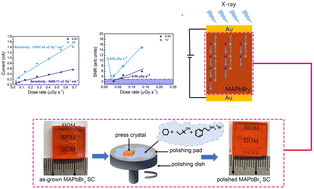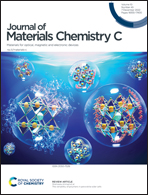Mechanical polishing with chemical passivation of perovskite single crystals for high-performance X-ray detectors†
Abstract
High-quality and large-size perovskite single crystals are promising candidates for radiation detection due to their outstanding optoelectronic properties. For detector application, large-size crystal ingots need to be sliced and polished. However, the commonly used polishing agent generally corrodes the surface and introduces defects during the polishing process. Here, we report a top-down method using an improved polishing agent, which does not bring in any major change in morphology. Furthermore, we combine mechanical polishing with chemical passivation to improve the crystal quality. Finally, the surface texture resulting from etching or recrystallization by precursor solution could be efficiently removed. We achieve high performance radiation detectors based on high-quality and large-size MAPbBr3 single crystals. The dark current and ion migration of MAPbBr3 single crystals are significantly suppressed after surface treatment, which enhances the dark current stability for over 10 hours. These superior properties enable us to realize high-performance X-ray detectors with a sensitivity of 21897.44 μC Gy−1 cm−2 and the lowest detection limit of 25 nGy s−1 at 1 V bias. Furthermore, radiographic imaging with 1 mm spatial resolution is demonstrated at a dose rate of about 100 nGy s−1.



 Please wait while we load your content...
Please wait while we load your content...